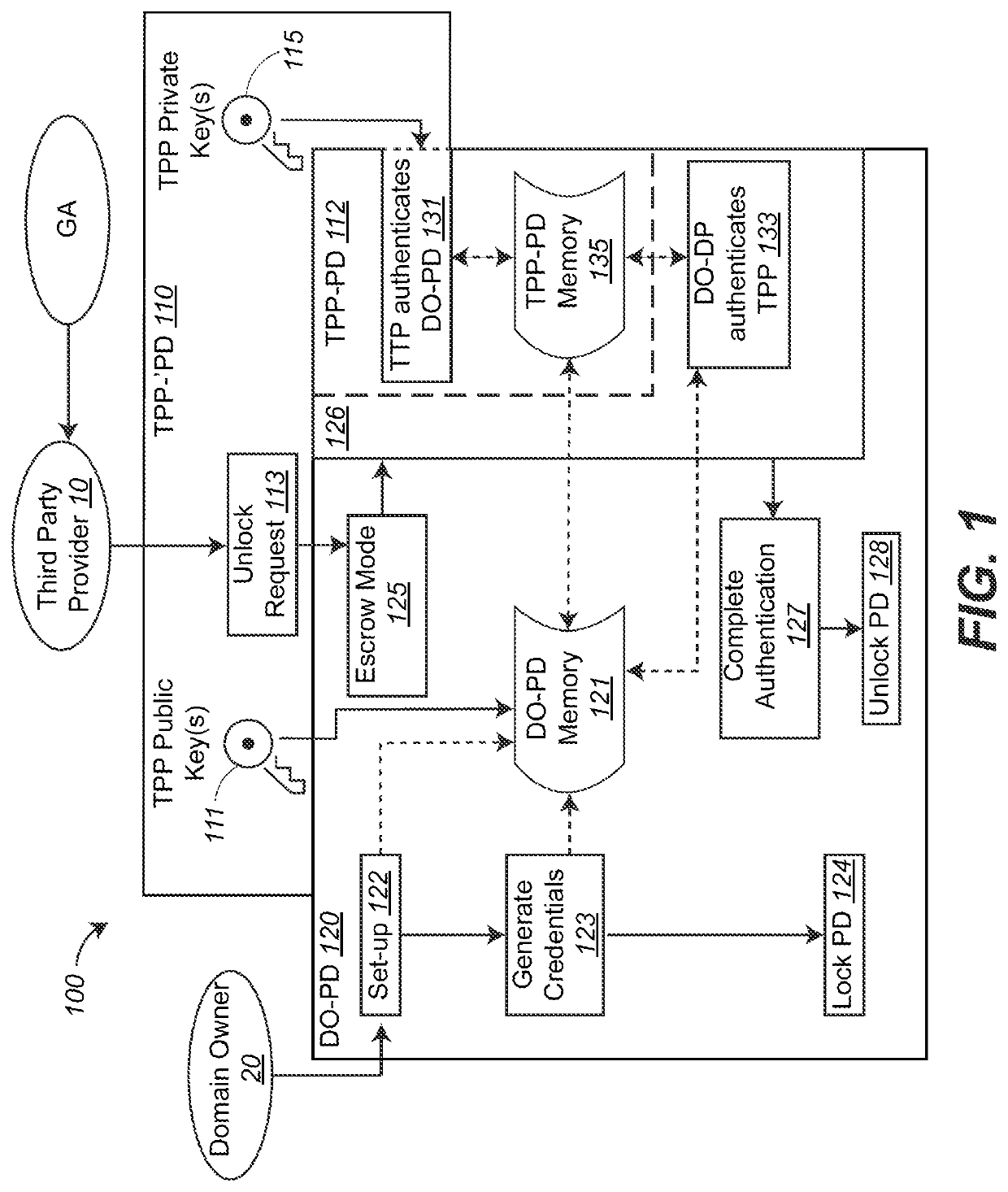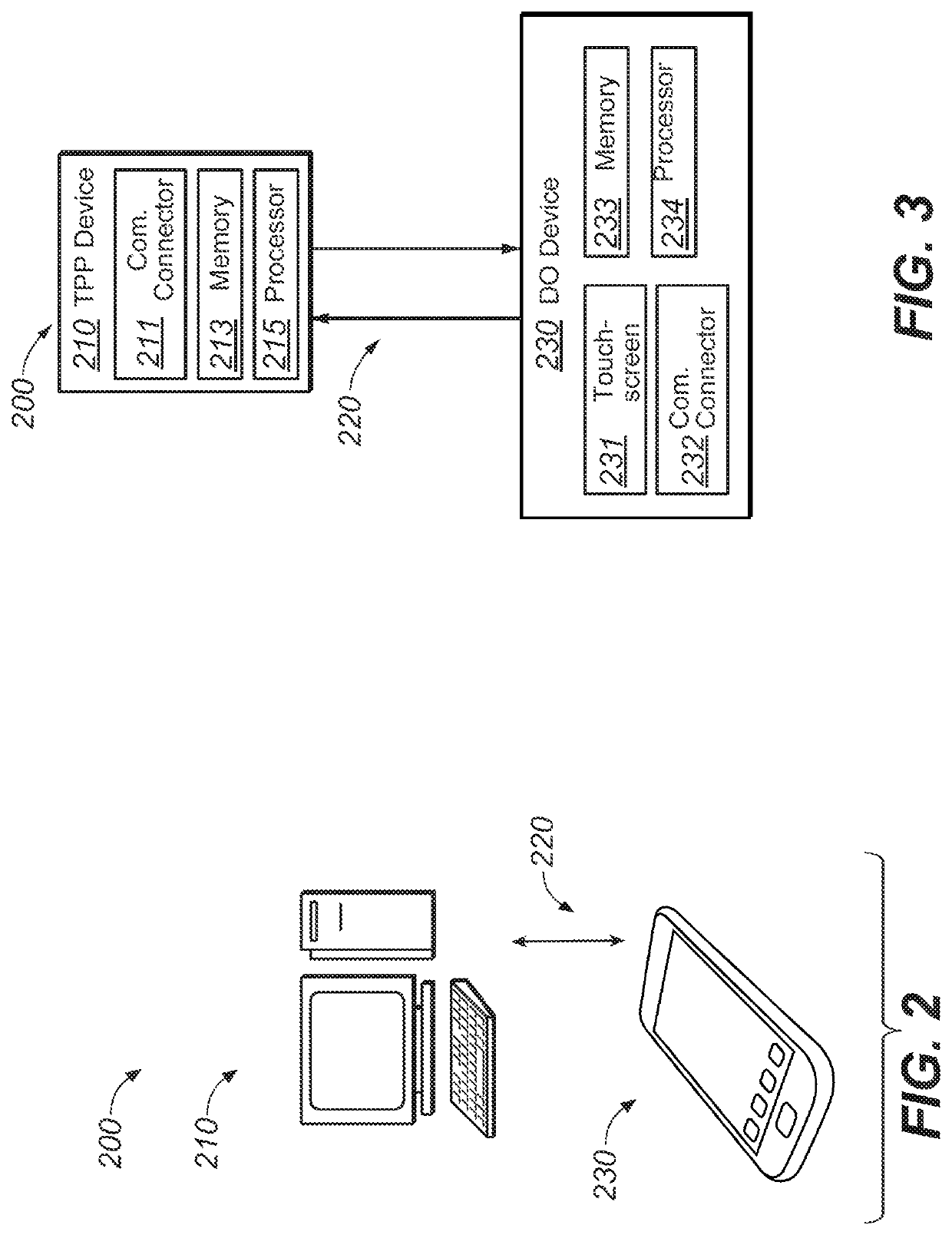Exclusive self-escrow method and apparatus
a self-escrow and program domain technology, applied in the field of secure unlocking a program domain, can solve the problems of unauthorized reduction of the owner's security, backdoors are problematic, backdoors are susceptible to hacking, theft, misuse, etc., and achieves the effects of improving security, convenient use, and robustness
- Summary
- Abstract
- Description
- Claims
- Application Information
AI Technical Summary
Benefits of technology
Problems solved by technology
Method used
Image
Examples
embodiments
[0100]Each embodiment of the exclusive self-escrow methods presented herein utilizes some combination of different messages (access data) and content, encryption methods (asymmetric and symmetric), and one-way function credential types, to accomplish authentication of the program domain and the third-party(s). Whereas public key encryption provides a means for protecting authenticating one-way function credentials, symmetric encryption provides for both producing and protecting one-way function credentials for bi-directional authentication. Each type of credential exhibits a unique functional character that supports its role in authentication, with a focus on one-way functionality and state expression. The HSA (hardware secure area), on certain devices, can substitute for an encrypted message.
[0101]Several embodiments of the method illustrated in schematic 100 are now presented in greater detail. The following discussion make reference to actions between DO-PD 120,TPP-′PD 110, and T...
first embodiment
[0105]A first embodiment exclusive self-escrow method is shown in FIG. 4 as a flowchart 401 and a flowchart 402, where flowchart 401 includes steps for locking DO-PD 120 in blocks 411-419, and where flowchart 402 includes steps for then unlocking the DO-PD locked according to the steps of flowchart 401 in blocks 421-437. To aid in illustrating which domains which each of the blocks in FIG. 4 are executed in, the blocks are aligned along vertical dashed lines domains labeled TPP-′PD 110, TPP-PD 112 and DO-PD 120.
[0106]DO-PD 120 may be locked according to the steps of flowchart 401. as per blocks 122, 123, and 124, as follows:
[0107]In block 411, TPP 10 creates a TPP key pair as a TPP private key and a TPP public key. The TPP private key is stored in TPP-'PD 110 and the TPP public key is provided to and stored in DO-PD memory 121.
[0108]In block 412, after DO 20 engages with DO-PD 120, DO-PD 120, using P, creates a PD key pair as a PD private key and a PD public key, which are stored in...
second embodiment
[0136]A second embodiment exclusive self-escrow method is shown in FIG. 5 as a flowchart 501 and a flowchart 502, where flowchart 401 includes steps for locking DO-PD 120 in blocks 511-526, and where flowchart 402 includes steps for then unlocking the DO-PD locked according to the steps of flowchart 501 in blocks 527-549. The second embodiment exclusive self-escrow method is generally similar to the previous embodiment exclusive self-escrow methods, except as explicitly stated.
[0137]This embodiment illustrates a second third party, denoted “TP” which has a device with a TP-′DP partition similar to the TTP-′PD partition.
[0138]DO-PD 120 may be locked according to the steps of flowchart 501, as per blocks 122, 123, and 124, as follows:
[0139]In block 511, TTP-′PD 110 creates a TPP key pair as a TPP private key and a TPP public key, and creates a symmetric TPP key pair as a symmetric TPP private key and a symmetric TPP public key, and provides the TPP public key and the symmetric TPP pub...
PUM
 Login to View More
Login to View More Abstract
Description
Claims
Application Information
 Login to View More
Login to View More - R&D
- Intellectual Property
- Life Sciences
- Materials
- Tech Scout
- Unparalleled Data Quality
- Higher Quality Content
- 60% Fewer Hallucinations
Browse by: Latest US Patents, China's latest patents, Technical Efficacy Thesaurus, Application Domain, Technology Topic, Popular Technical Reports.
© 2025 PatSnap. All rights reserved.Legal|Privacy policy|Modern Slavery Act Transparency Statement|Sitemap|About US| Contact US: help@patsnap.com



